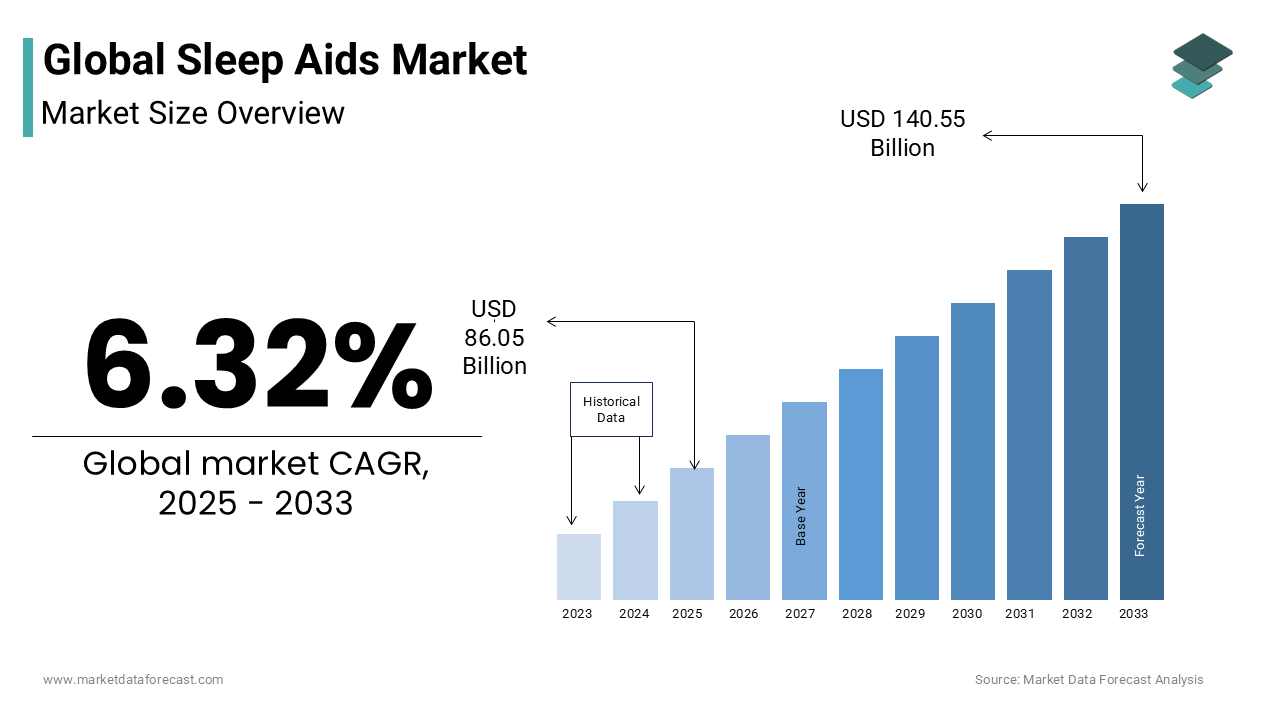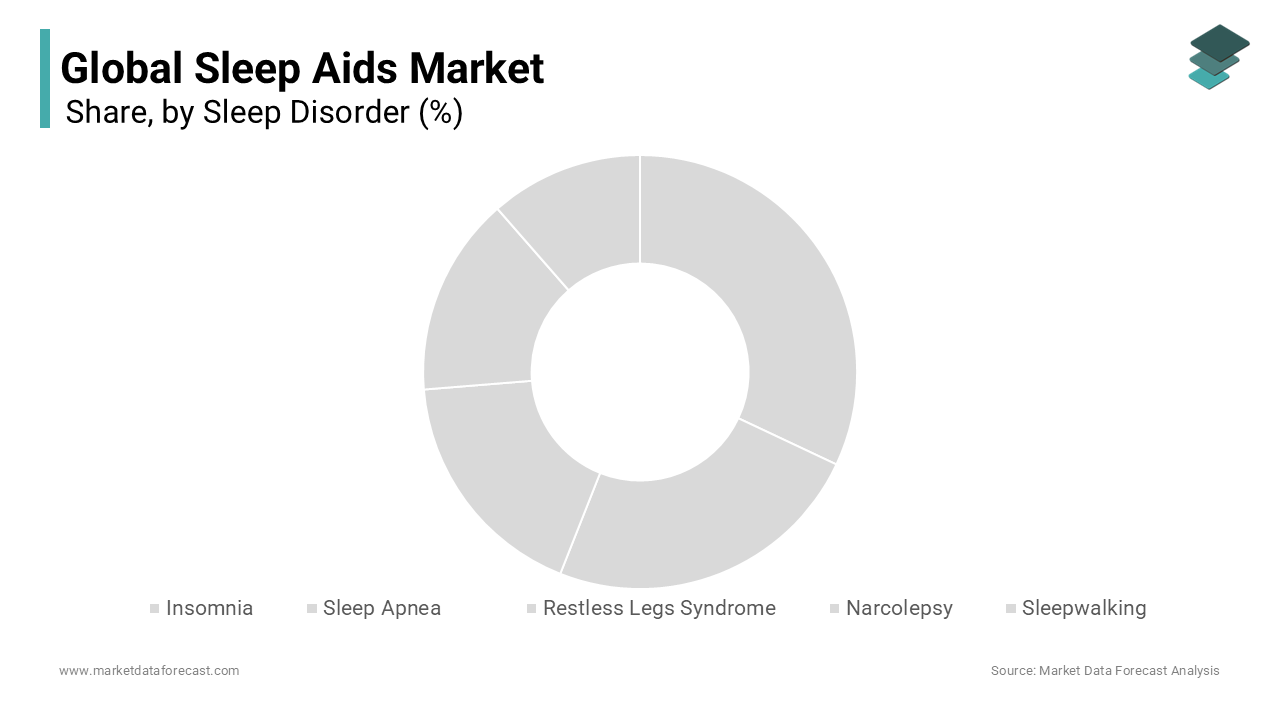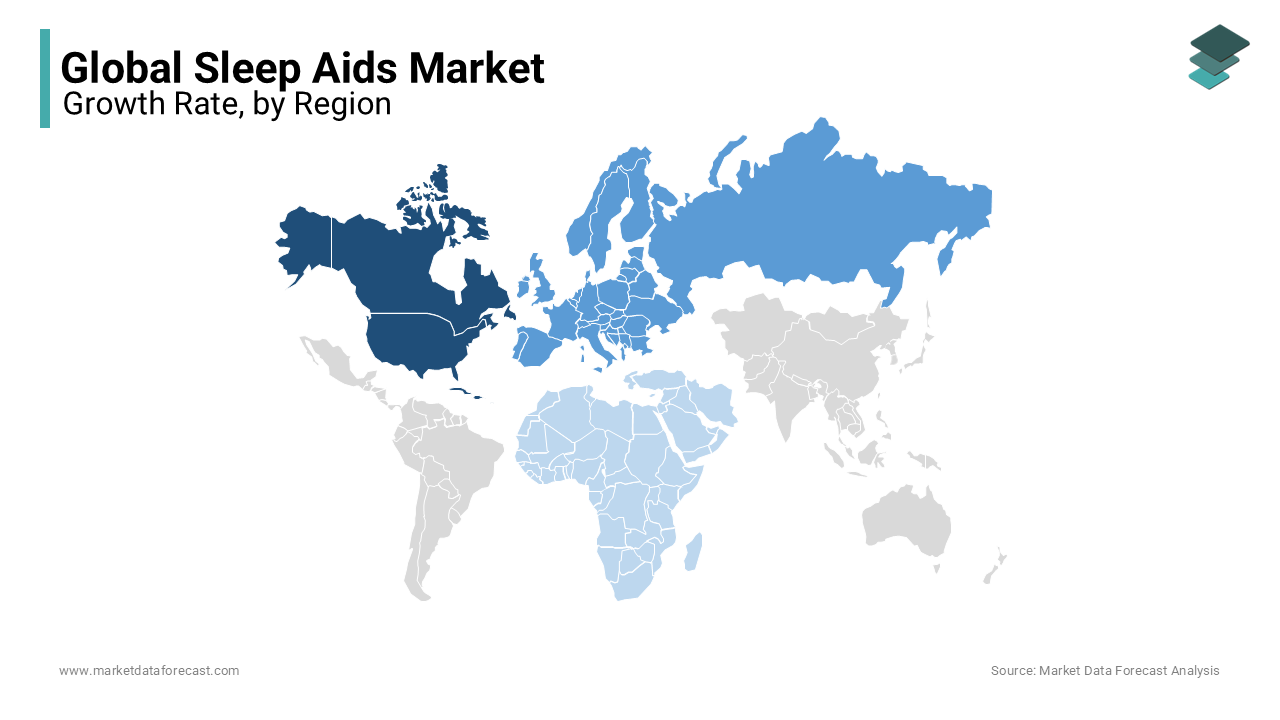Global Sleep Aids Market Size, Share, Trends & Growth Forecast Report - Segmented By Sleep Order (Insomnia, Sleep Apnea, Restless legs syndrome, Narcolepsy and sleepwalking), Product (Mattresses & Pillows, Sleep Laboratories, Medication and Sleep Apnea Devices), Medication Type, and Region - Industry Analysis From 2025 to 2033
Global Sleep Aids Market Size
The global sleep aids market size was valued at USD 80.96 billion in 2024. The size of the global sleep aids market is predicted to be worth USD 140.55 billion by 2033 from USD 86.08 billion in 2025, registering a CAGR of 6.32% during the forecast period.

Current scenario of Sleep Aids Market
Sleep aids are medications or herbs that help induce sleep. The sleep aids can be prescription drugs or over-the-counter drugs and are also available as dietary supplements. The sleep aids work in various ways by altering the body's circadian rhythms or blocking brain chemicals. Sleep aids are widely prescribed for people who have insomnia and other sleeping disorders. Sleeping pills work by inducing sleep and making people feel tired and relaxed. Most of the sleep aids available without prescription contain antihistamines and the tolerance to the antihistamines can be developed so quickly. The global sleep aids market has witnessed the most significant growth in the past years and is anticipated to have notable growth during the forecast period. Sleeping disorders negatively influence human health, leading to chronic diseases and being the primary factor contributing to the demand for sleep aids, leading to market revenue growth. According to the data published by the National Council on Aging, around 30% of adults have symptoms of insomnia. Additionally, various sources state that the prevalence of sleep problems and insomnia symptoms was around 41.58% and 41.56%.
MARKET DRIVERS
The growing population suffering from sleeping difficulties is primarily boosting the sleep aids market growth.
The growing geriatric population worldwide and shifting trends to maintain a healthy lifestyle by maintaining a good sleep cycle are primarily promoting the growth of the sleep aids market. Nowadays, people are experiencing many health disorders due to lack of proper sleep, which may be due to hectic work, stress, and others, which is also an attribute accelerating the growth of the global sleep aid market.
The rise in the popularity of over-the-counter drugs, which can be available easily from pharmaceutical stores, is anticipated to create growth opportunities for the sleep aids market.
The adoption of newly launched therapeutic devices, especially in developed and developing countries, is ascribed to bolster the growth of the sleep aids market. The emergence of advanced technologies for treating sleep disorders, including monitoring and diagnosing, significantly supports the global market growth. Ongoing research on developing innovative drugs with adequate quality and reducing complications fuels the demand for sleep aids. The availability of healthcare professionals to analyze the ill effects of sleep disorders will also help manufacture effective sleep aid devices.
The growing patient count who has cancer drives the sleep aids market growth.
Insomnia is one of the significant issues among cancer patients, and these cancer patients face difficulties in falling asleep and awakening early. Therefore, the increasing prevalence of Insomnia among cancer patients is expected to boost the demand for sleep aid products and drive market growth. In addition, these cancer patients use herbal medicine or personalized medication for insomnia diseases because they may have severe side effects from using drugs compared to other people.
MARKET RESTRAINTS
The availability of raw materials for manufacturing sleep aids and the growing awareness among people regarding the issues associated with the long-term usage of sleep aids are expected to hinder the market's growth rate. In addition, poor awareness levels among manufacturers regarding dosage forms in some underdeveloped countries are expected to impede market growth. Furthermore, stringent rules and regulations by the governments to manufacture and commercialize sleep aid products are another notable factor inhibiting the market's growth rate. Chronic insomnia could be a life-threatening disease. Due to poor awareness levels, more than 50% of the patients are not taking the required care to cure this disease; such factors are anticipated to impact the sleep aids market growth negatively.
REPORT COVERAGE
|
REPORT METRIC |
DETAILS |
|
Market Size Available |
2024 to 2033 |
|
Base Year |
2024 |
|
Forecast Period |
2025 to 2033 |
|
Segments Covered |
By Sleep disorder, Product, Medication Type, and Region |
|
Various Analyses Covered |
Global, Regional & Country Level Analysis, Segment-Level Analysis; DROC, PESTLE Analysis, Porter's Five Forces Analysis, Competitive Landscape, Analyst Overview of Investment Opportunities |
|
Regions Covered |
North America, Europe, APAC, Latin America, Middle East & Africa |
|
Market Leader Profiled |
Sanofi, Merck & Co, Pfizer, Koninklijke Philips N.V. (Philips), GlaxoSmithKline Plc, Care Fusion Corporation, Cadwell, SleepMed, Natus Medical Manufactures, and DeVilbiss Healthcare LLC. |
SEGMENTAL ANALYSIS
By Sleep Disorder Insights
The insomnia segment is predicted to capture the largest share of the global sleep aids market owing to growing insomnia among the aging population. According to an NCBI article, the symptoms of insomnia can be seen in 75% of aged people worldwide; factors such as increased work stress, depression, anxiety disorders, and increasing consumption of smoking and alcohol are contributing to the growing burden of insomnia among people.

The sleep apnea segment is anticipated to showcase the fastest CAGR during the forecast period. The growing aging population is one of the major factors contributing to segmental growth. According to the World Health Organization (WHO), one in every six people is expected to reach 60 years of age by 2030. Therefore, the incidence of sleep apnea is higher among the aging population. In addition, the growing manufacturing activities of sleep apnea devices and rising disposable income among the population of developed and developing countries favor the segment's growth rate.
The sleepwalking and restless Legs Syndrome segment is forecasted to have prominent growth during the forecast period. Increasing sleepwalking and restless syndrome cases have covered the inflow of voluminous growth in the sleep aids market globally. Sleepwalking is also one type of sleep disorder. People suffering from this disease walk or do some tasks while sleeping. These people must use sleep aids to reduce accidents or any other thing happening due to their disorder. Due to the increase in this type of disease in most regions, the segment has the largest share in the market growth.
By Product Insights
The mattresses and pillows segments will continue leading the sleep aids market in the coming years. The features of these products, such as comfort, conformity, accessibility of various products, and relatively cheap, are majorly driving segmental growth. Most companies are focusing on manufacturing different types of pillows and mattresses with advanced technology. Researchers take the suggestion of doctors and people to manufacture according to medical usage. Many people have been concentrating more on their health in recent years, and one of the essential things they focus on is sufficient sleep. Considering all the factors, we know that the mattress and pillow segment has the highest market share. Also, increasing awareness regarding the health advantages of quality sleep amid the rise in population accelerates the sleep aids market growth globally during the forecast period.
The medications segment is another segment growing at a promising CAGR during the forecast period. Most people prefer taking medication to get good sleep. People of any age use these sleep medications according to the doctor's prescription. Increasing sleep disorders in every age, increasing stress due to family and work problems, and increasing chronic diseases such as diabetes are the factors that drive the segment's growth forward.
By Medication Type Insights
Based on medication type, the prescription-based drugs segment is estimated to hold the largest share of the market during the forecast period. People suffering from lack of sleep and sleep disorders are increasing globally, which is anticipated to fuel the segment's growth. Researchers are focusing on plant extracts used to get insomnia patients to sleep. Chamomile is a popular herbal drug used as a remedy for sleep. This is also used as an anti-inflammatory and anti-bacterial property. FDA approves these herbal medicines. Using this herbal drug as a sleep aid will reduce the side effects caused by using the sleep aid drugs.
On the other hand, the OTC drugs segment is also estimated to showcase a healthy CAGR during the forecast period.
REGIONAL ANALYSIS

Geographically, the global sleep aids market was dominated by North America in 2023, with an overall market share of over 50% globally. Europe and Asia-Pacific followed North America. The North American market is predicted to occupy most of the share in the global market owing to the rapid adoption of the latest technologies. In addition, the increasing R&D efforts by the market participants to develop sleep aid products with fewer or no side effects using herbs and natural products is anticipated to have a favorable impact on the North American sleep aids market growth. According to a recent survey, nearly 60 million people in America suffer from sleep disorders affecting their daily activities and health conditions. Sedative and hypnotic medications are primarily used as drug sleep aids, which are used to maintain sleep by suppressing activities in the central nervous system. Almost one-third of older people in the U.S. take sleeping pills that induce sleep for at least 6-7 hours. In this region, sleep medications are used mainly by women due to poor health and less quality sleep. In Canada, these sleep aids are also used for children. Hormone supplement melatonin was the most used sleep aid in children in this region.
Europe is anticipated to account for a substantial market share during the forecast period. An increasing number of sleep apnea cases across the European region is boosting the demand for sleep aids in Europe. In addition, creating awareness of the availability of different treatment procedures for sleep disorders boosts the market demand in this region. For example, recent studies show nearly 25 percent of United Kingdom people suffer from insomnia symptoms.
The sleep aids market in the Asia Pacific is expected to hit the highest CAGR in the coming years. The rise in the consumption rate of tobacco and alcohol is leveraging the market demand in this region. India and China are major countries contributing to the largest share of the sleep aids market. More than 300 million people in China are suffering from sleep disorders, as per the China Sleep Research Society. Many people are focused on completing their daily work, and personal issues lead to stress and disturbance in the sleep cycle. These sleep disorders are more common in young people in China due to stress and heavy work at offices. Sleeping disorder also affects the quality of life and may cause major issues in transportation and industrial safety. There are various sleep aid applications in China. These sleep aid apps help to reduce the disorder and get good sleep. In Japan, most people suffering from sleep disorders use psychotropic drugs. In addition, most people use benzodiazepine medications to promote sleep. Considering all these factors, the market has grown in this region during the forecast period.
Latin America had moderate growth all these years but is anticipated to witness a healthy CAGR during the forecast period. The growth of the sleep aids market in Latin America is primarily attributed to factors such as the increasing use of intelligent gadgets late at night and people being more aware of their health condition. In addition, most people in Brazil suffer from obesity and are overweight due to sleep problems. As a result, an increase in the consumption of benzodiazepine and melatonin for sleep disorders in Brazil will drive the market forward in this region. In Brazil, this medication can be found in drugstores and online shops.
The sleep aids market in Middle East and Africa also has mild growth due to increasing awareness about sleep aid products and devices that help people get sufficient sleep and reduce stress. In addition, the government has started focusing on approving drugs and devices used for sleep-related disorders.
KEY PLAYERS IN THE SLEEP AIDS MARKET
'Some of the notable companies dominating the global sleep aids market profiled in this report are Sanofi, Merck & Co, Pfizer, Koninklijke Philips N.V. (Philips), GlaxoSmithKline Plc, Care Fusion Corporation, Cadwell, SleepMed, Natus Medical Manufactures, and DeVilbiss Healthcare LLC.
RECENT HAPPENINGS IN THE GLOBAL SLEEP AIDS MARKET
-
In June 2024, Wakefit launched an innovative solution to enhance sleep quality with an AI-powered mattress and tracker. These products, Regul8, and Track8, leverage advanced AI technology to improve sleep quality significantly. By accelerating AI technology, Wakefit has introduced a product that induces sleep and ensures a restful and rejuvenating experience.
-
In May 2023, Hapbee Technologies, Inc. announced its development of the Hapbee Smart Pad, and the company also stated its collaboration with Reputable Health, which customizes sleep routines that are available through Hapbee products. These products are derived from artificial intelligence-driven algorithms that analyze the consumer's sleep data gathered from the Reputable Health platform.
-
In 2022, the Sleepio app received the National Institute for Health and Care Excellence guidance for treating insomnia disease. Sleepio, an app, was developed by London-based Big Health Ltd. It is a safe and effective treatment for people who are suffering from Insomnia.
-
In 2021, the U.S. Food and Drug Administration (FDA) approved the daytime treatment for mild sleep apnea. In addition, Signifier Medical Technologies has launched an eXciteOSA, an intraoral neuromuscular stimulation device for treating sleep apnea. There is an app for this device designed to give personalized care and motivate patients to achieve high therapy adherence.
-
In 2020, Dayvigo was approved by the FDA as a drug for insomnia. The drug is available in 5 or 10 milligrams (mg) doses and used according to the doctor's prescription.
-
In July 2019, Dr. Reddy's Laboratories launched generic Ramelteon tablets of 8mg strength, which treat Insomnia.
MARKET SEGMENTATION
This research report on the global sleep aids market has been segmented and sub-segmented based on sleep disorder, product, medication type, and region.
By Sleep Disorder
- Insomnia
- Sleep Apnea
- Restless Legs Syndrome
- Narcolepsy
- Sleepwalking
By Product
- Mattresses & Pillows
- Sleep Laboratories
- Medication
- Sleep Apnea Devices
By Medication Type
- Prescription-Based Drugs
- OTC Drugs
- Herbal Drugs
By Region
- North America
- Europe
- Asia-Pacific
- Latin America
- Middle East and Africa
Frequently Asked Questions
Which segment by disorder led the sleep aids market in 2025?
The global sleep aids market size was valued at USD 86.08 billion in 2025.
Which region dominated the sleep aids market in 2024?
Geographically, the North American region accounted for the most dominant share in the global market in 2024.
Who are some of the noteworthy players in the sleep aids market?
Sanofi, Merck & Co, Pfizer, Koninklijke Philips N.V. (Philips), GlaxoSmithKline Plc, Care Fusion Corporation, Cadwell, SleepMed, Natus Medical Manufactures, and DeVilbiss Healthcare LLC. are some of the promising players in the sleep aids market.
Related Reports
Access the study in MULTIPLE FORMATS
Purchase options starting from
$ 2500
Didn’t find what you’re looking for?
TALK TO OUR ANALYST TEAM
Need something within your budget?
NO WORRIES! WE GOT YOU COVERED!
Call us on: +1 888 702 9696 (U.S Toll Free)
Write to us: sales@marketdataforecast.com
